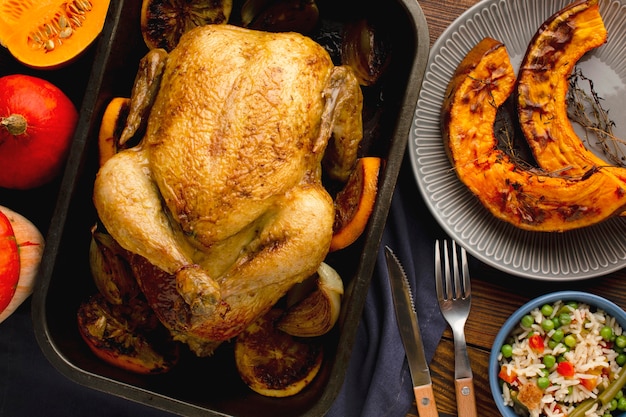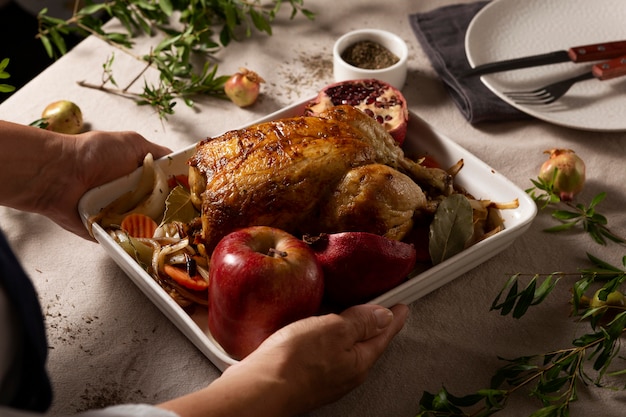(Part 1) Choosing Your Turkey: Setting the Stage for Success

Picking the Perfect Bird
First things first, you need to choose the right turkey. I always go for a free-range bird – they're usually a bit more flavorful. When it comes to size, it really depends on how many people you're feeding, but I find a 4-5kg turkey is perfect for a big Christmas dinner.Prepping Your Turkey: Getting Ready to Cook
Once you've got your turkey, it's time to prep it. I like to remove the giblets and neck, and give the bird a good rinse. Then, I pat it dry with some kitchen paper, stuff it with my favorite herbs and spices (I'm a big fan of rosemary and thyme), and pop it in a roasting tin.(Part 2) The Temperature Truth: The Science of cooking a turkey

Turkey cooking times and Temperatures: The Golden Rules
Okay, now for the crucial part. The turkey needs to be cooked through to an internal temperature of 74°C (165°F). This ensures it's safe to eat and also helps prevent any bacteria from surviving. But the time it takes to reach that temperature varies depending on the size and weight of the bird and the cooking method you choose.Understanding Cooking Times: A Rough Guide
A good rule of thumb is to allow 20 minutes per 450g (1lb) of turkey. So, a 4.5kg (10lb) turkey will take roughly 3 hours. But don't just rely on that – always use a meat thermometer to check the internal temperature. You want it to reach 74°C (165°F) in the thickest part of the thigh, which is usually the most difficult part to cook through.(Part 3) Roasting: The Classic Method

The Classic Roast: A Timeless Favourite
Roasting is the most traditional way to cook a turkey. I love the way it gives the skin a beautiful golden-brown colour and a crispy texture. It just screams "Christmas dinner" to me.roasting temperature and Time: Getting the Basics Right
For a roast turkey, preheat your oven to 180°C (350°F). Place the turkey in the roasting tin and cook for around 15 minutes per 450g (1lb). But remember to check the internal temperature using a meat thermometer every 30 minutes. You want it to reach 74°C (165°F) in the thickest part of the thigh.Tips for perfect roasting: Elevate Your Turkey Game
To ensure your turkey is juicy and delicious, baste it with the pan juices every 30 minutes. This keeps the bird moist and adds flavour. You can also add some vegetables like carrots, onions and celery to the roasting tin to create a delicious gravy. And don't forget to tent the turkey with foil for the first part of the cooking time to prevent it from drying out. Then, remove the foil for the last 30 minutes to brown the skin. This method helps you achieve a crispy skin and juicy meat.(Part 4) Oven-Baking: A Quick and Convenient Option
Oven-Baking: The Modern Way
I'm a busy person, so I often opt for oven-baking my turkey. It's a quick and convenient method that gives me more time to focus on other things. And it still delivers a delicious result.Oven-Baking Temperature and Time: A Speedy Approach
Preheat your oven to 180°C (350°F) and bake the turkey for about 15 minutes per 450g (1lb). Again, check the internal temperature with a meat thermometer. It should reach 74°C (165°F).Oven-baking tips and Tricks: Making the Most of This Method
When oven-baking, it's a good idea to cover the turkey with foil for the first part of the cooking time to help prevent it from drying out. Then, remove the foil for the last 30 minutes to brown the skin. This method helps you achieve a crispy skin and juicy meat.(Part 5) Deep-Frying: For a Crispy Skin and Juicy Meat
Deep-Frying: The Ultimate Crispy Skin
Deep-frying is another option. I love how it gives the turkey an incredibly crispy skin. But it's a bit more technical, so I only do it when I'm feeling extra confident in the kitchen. It's not for the faint of heart, but the results are worth it.Deep-Frying Temperatures and Time: A High-Heat Experience
You need a large, deep fryer filled with oil heated to 177°C (350°F). Gently lower the turkey into the hot oil and cook it for around 5-7 minutes per 450g (1lb).Deep-Frying Safety and Tips: Navigating This Method Safely
Deep-frying is a risky business, so it's important to be careful. Never overcrowd the fryer, and use a thermometer to monitor the oil temperature. Always ensure the oil is hot enough before you add the turkey. And, obviously, never leave it unattended. It's also important to make sure your fryer is large enough to accommodate the turkey without overcrowding. If you’re using a turkey fryer outdoors, make sure it’s placed on a flat, stable surface and far away from any flammable materials.(Part 6) Slow-Cooking: A Tender and Juicy Option
Slow-Cooking: For a Tender and juicy turkey
For the ultimate in juicy and tender turkey, I'd recommend slow-cooking. It's a super-easy and stress-free method that produces the most delicious results. You just set it and forget it, and the turkey will be ready when you are.Slow-Cooking Temperature and Time: A Low-and-Slow Approach
Set your slow cooker to low heat and cook the turkey for 6-8 hours. It's important to check the internal temperature with a meat thermometer to ensure it reaches 74°C (165°F).Slow-cooking tips and Tricks: Maximizing Flavor and Tenderness
For extra flavour, add some vegetables and herbs to the slow cooker with the turkey. You can also add a little bit of broth to keep the turkey moist. Just make sure you don't overfill the slow cooker, as you need space for the turkey to cook evenly.(Part 7) Grilling: For a Smoky Flavour
Grilling: For the BBQ Enthusiast
If you’re a BBQ fan like me, you'll love grilling your turkey. It gives it a lovely smoky flavour and crispy skin. It's a great way to add a bit of a summery vibe to your Christmas dinner, even if it's a bit chilly outside.Grilling Temperature and Time: Achieving that Smoky Goodness
Preheat your grill to medium heat and cook the turkey for 15 minutes per 450g (1lb). Turn it occasionally to ensure even cooking. Again, use a meat thermometer to check the internal temperature. You want to aim for 74°C (165°F) in the thickest part of the thigh.grilling tips and Tricks: Making the Most of Your Grill
To prevent the turkey from sticking to the grill, use a non-stick grilling mat. You can also create a delicious marinade using your favourite herbs and spices. And don't forget to baste the turkey with the pan juices every 30 minutes to keep it moist.(Part 8) Smoking: For a Unique Flavour
Smoking: For a Gourmet Touch
If you're looking for something a bit more adventurous, try smoking your turkey. It gives it a unique, smoky flavour that is perfect for a special occasion. It's not for the faint of heart, but it's certainly a showstopper.Smoking Temperature and Time: A Long, Slow Process
Set your smoker to 107°C (225°F) and cook the turkey for around 4-6 hours, depending on the size. Smoke the turkey until it reaches an internal temperature of 74°C (165°F).Smoking Tips and Tricks: Mastering the Art of Smoking
Use a mix of hardwood chips like hickory, cherry, or applewood for the best flavour. Make sure to soak the wood chips in water for 30 minutes before adding them to the smoker. And don't forget to keep the smoker fuelled with wood chips throughout the cooking process.(Part 9) The Importance of Resting: Letting Your Turkey Relax
Resting Your Turkey: A Crucial Step
After you've cooked your turkey, it's crucial to let it rest for at least 30 minutes before carving. This allows the juices to redistribute throughout the meat, making it juicier and more tender.Resting Techniques: Keeping Your Turkey Warm
Cover the turkey loosely with foil while it rests. This will keep it warm and help the juices to redistribute. You can also use a carving board with a well to catch the juices, which you can use to make a delicious gravy.(Part 10) Checking for Doneness: Ensuring Your Turkey is Safe to Eat
Checking for Doneness: The Meat Thermometer
To make sure your turkey is cooked through, you must use a meat thermometer. Insert it into the thickest part of the thigh, making sure it doesn't touch any bone. The temperature should reach 74°C (165°F).Other Signs of Doneness: Visual Clues to Help You
While a meat thermometer is the most reliable way to check for doneness, there are other signs to look out for. The turkey juices should run clear, and the skin should be golden-brown and crispy.(Part 11) The Ultimate turkey cooking guide: A Comprehensive Overview
Here is a table to summarise the different cooking methods for your turkey, including the recommended temperature and time:| Cooking Method | Temperature (°C) | Time (per 450g/1lb) |
|---|---|---|
| Roasting | 180 | 15 minutes |
| Oven-Baking | 180 | 15 minutes |
| Deep-Frying | 177 | 5-7 minutes |
| Slow-Cooking | Low | 6-8 hours |
| Grilling | Medium | 15 minutes |
| Smoking | 107 | 4-6 hours |
(Part 12) FAQs: Your Turkey Cooking Questions Answered
What happens if the turkey is undercooked?
If the turkey is undercooked, it can be dangerous to eat because it may contain bacteria that can cause food poisoning. Always ensure the turkey is cooked through to an internal temperature of 74°C (165°F).
What happens if the turkey is overcooked?
An overcooked turkey will be dry and tough. It's important to monitor the cooking time and use a meat thermometer to prevent overcooking.
Can I stuff the turkey before cooking it?
Stuffing the turkey before cooking it can increase the risk of food poisoning. The stuffing may not reach a safe internal temperature. It's best to cook the stuffing separately.
How long can I keep cooked turkey in the fridge?
Cooked turkey can be kept in the fridge for 3-4 days. Store it in an airtight container to prevent it from drying out.
What should I do with leftover turkey?
Leftover turkey can be used in a variety of dishes, such as turkey sandwiches, turkey soup, or turkey salad. It's also delicious reheated as a meal.
I hope this guide has helped you understand the perfect turkey cooking temperature and has given you some tips and tricks to ensure your Christmas turkey is delicious and safe to eat. Happy cooking!Everyone is watching

Corn on the Cob: The Ultimate Guide to Perfectly Cooked Ears
Healthy MealsAh, corn on the cob. Just the name evokes images of sunny days, barbecues, and that sweet, juicy flavour that ...

Perfect Pork Roast Oven Cooking Time: A Guide to Delicious Results
Healthy MealsThere's something truly satisfying about a perfectly roasted pork. The aroma alone is enough to make your mout...

Ham Cooking Time: How Long to Bake, Smoke, or Boil a Delicious Ham
Healthy MealsAh, ham. It's a classic, isn't it? A real crowd-pleaser, especially around holidays. And when done right, it'...

Scallops: The Ultimate Guide to Perfect Cooking
Healthy MealsAh, scallops. Those delicate, sweet, and utterly delicious morsels of the sea. They hold a special place in my...

Spaghetti Squash: The Ultimate Guide to Cooking and Serving
Healthy MealsRemember that time you saw spaghetti squash at the supermarket, looking all bumpy and strange, and thought, "W...
